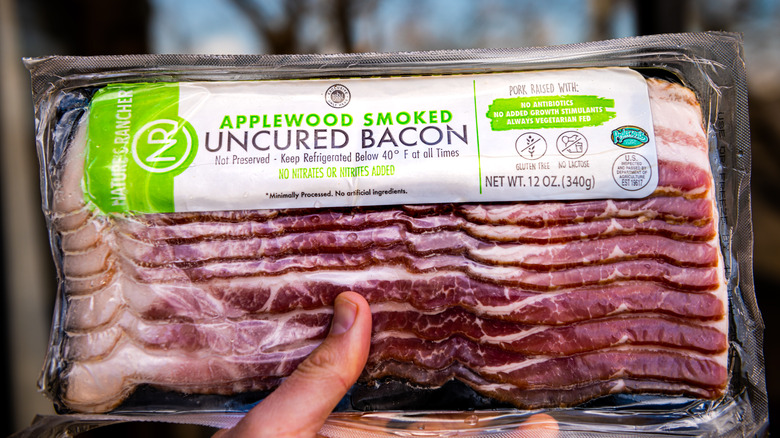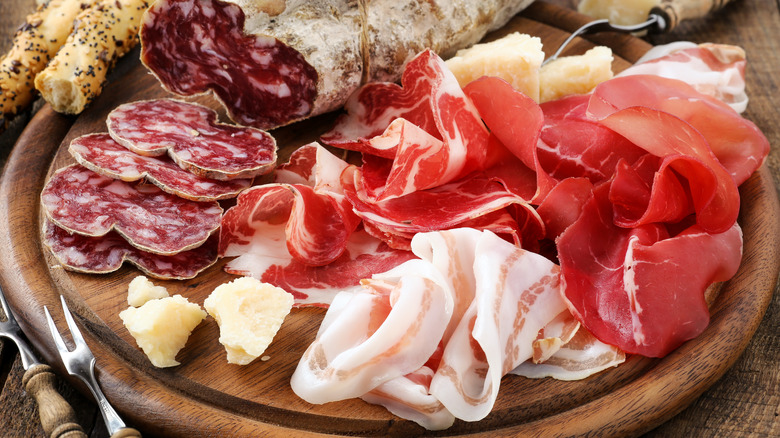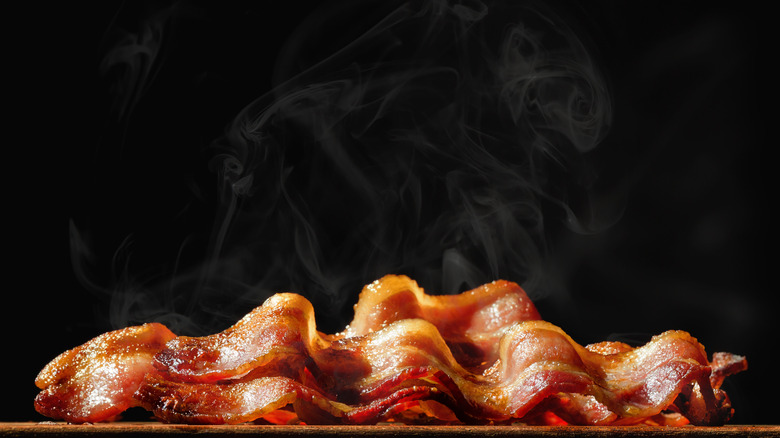'Uncured' Bacon Is Still Pretty Cured: The Odd Regulation Behind The Myth
Cured meats can be as unhealthy as they are delicious, which is to say, very unhealthy. It's especially frustrating because cured meats are everywhere — nearly every sandwich, breakfast platter, and charcuterie board features a big dose of cured meat such as ham, sausage, or bacon. In fact, as NBC News points out, a full quarter of all the meat and poultry eaten by Americans each year is processed, so it could be a much bigger portion of your diet than you realize. This has become a serious concern for many in the medical community, a growing number of whom are sounding the alarm on a particular chemical used in cured meats.
Curing involves treating the meat with a mixture of salt and nitrite. Both guard against spoilage, but nitrite is the chemical to focus on here. It inhibits the growth of harmful bacteria like Clostridium botulinum and Listeria monocytogenes and is notable for binding to the myoglobin in muscle tissue and turning cured meats pink. But here's the rub: the World Health Organization notes that nitrite might cause cancer. A growing number of studies have shown the connection, and it's leading people to rethink cured meat. A natural alternative would be uncured options, but sadly, they won't do you much good. Uncured meats can still be cured, thanks to one weird rule.
What makes cured meat unhealthy in the first place?
Uncured versions of bacon, ham, and hot dogs have all become popular based on health concerns about nitrite and a closely related compound called nitrate. In 2015, the World Health Organization (WHO) identified processed meat, which includes cured, smoked, fermented, and salted meats, as a carcinogen, specifically linking it to colorectal cancer. The WHO estimates that 34,000 cancer deaths worldwide can be attributed to diets high in processed meats. Red meat has also been linked to cancer, but that data is less conclusive, and more research is required. The clear problem with cured meats that sets them apart is the presence of nitrite.
A growing number of studies demonstrate that nitrite and nitrate can cause cancer, but it's not those chemicals themselves that really concern us. Many vegetables are quite high in nitrate and pose no threat to us. That's because nitrite and nitrate only become dangerous when they react with amino acids and heat to form something called nitrosamines – the real carcinogens. The problem is that meat is jam-packed with protein, which is made of amino acids, and since we cook it before we eat it, cured meat is essentially the ideal environment for nitrosamines to form. The evidence is clear-cut, and it would seem like the solution is too. If you want to avoid adding nitrite to your diet, buy meat that is labeled as 'uncured.' Right? Here's the problem with that.
How uncured meat can still be cured
Makers of cured meats can get nitrite from two different sources. They can choose synthetic sodium nitrite, or they can get it from a natural source, typically by converting the nitrate in vegetables such as celery and beets. What's important to note here is that, regardless of whether they come from a natural or synthetic source, nitrate and nitrite still pose the same carcinogenic risks when combined with protein and heat. Unfortunately, the United States Department of Agriculture only regulates the synthetic variety, so under USDA regulations, 'uncured' actually refers to meat that was cured using vegetable-derived nitrate. The USDA even allows these vegetable-cured meats to say "No Nitrate or Nitrite Added" on their labels. Since the USDA doesn't regulate vegetable-derived nitrate, 'uncured' meats can sometimes contain more nitrite than cured meat.
Many have pointed out that the USDA's regulations are bound to cause confusion, potentially leading people to believe their diet is safer than it truly is. In 2019, the Center for Science in the Public Interest petitioned the USDA to change its labeling rules. It took the agency over a year to respond (to be fair, 2020 was a bit of a turbulent stretch for the U.S. government) but the USDA finally agreed to pursue changes to their labeling standards by updating their definitions of 'cured' and 'uncured' and adding vegetable-based nitrate to their list of curing agents.


